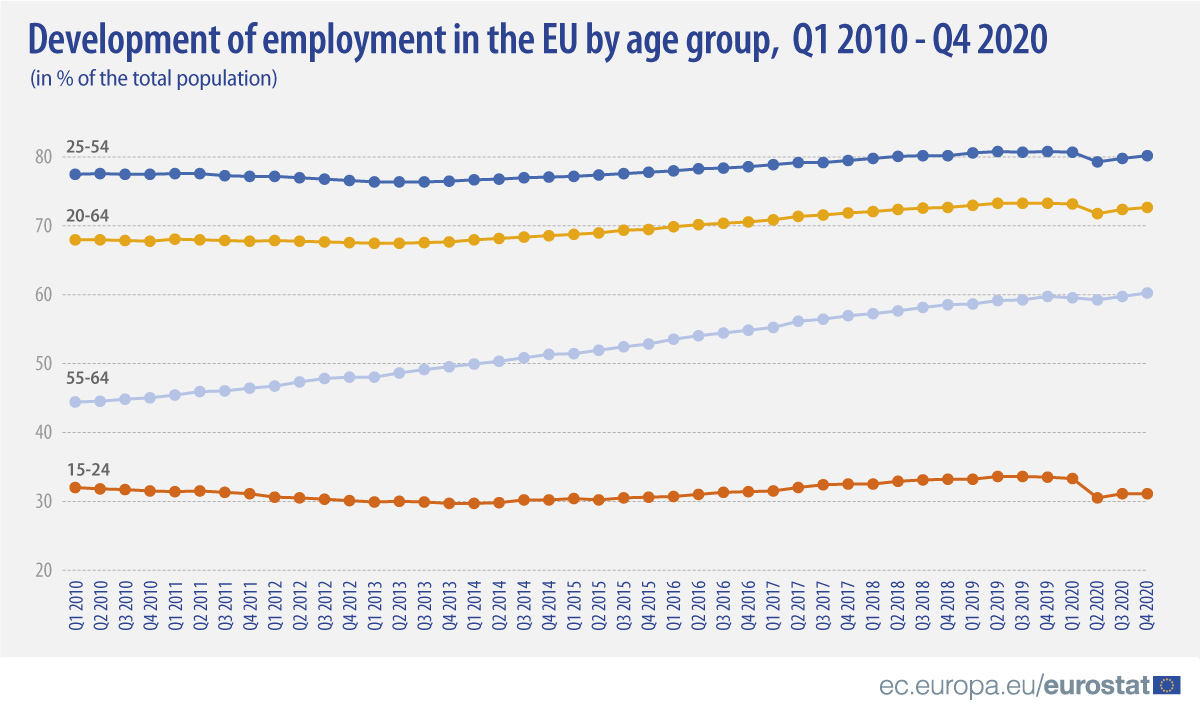Economic activity, and therefore the labour market across the EU, has been hit by the COVID-19 pandemic. There have been visible effects on employment, but people have also changed from being unemployed to being outside the labour force because their availability to work or their ability to seek work has been affected.
In the EU, the employment rate of people aged 20-64 was 72.6% in Q4 2020, still below the levels before the COVID-19 crisis (73.2% in Q4 2019) but above the level recorded in Q2 2020 (71.7%), the first quarter affected by COVID-19.
Compared with other age groups, young people aged 15-24 saw the sharpest drop in employment during the health crisis. The employment rate of young people slightly decreased from 33.5% in Q4 2019 to 33.3% in Q1 2020, dropped to 30.5% in Q2 2020, after which it increased and remained stable at 31.1% in Q3 and Q4 2020.
This information comes from data on the labour market in the fourth quarter of 2020 published by Eurostat today. The article presents only a handful of findings from the more detailed Statistics Explained articles on key figures on the impact of the COVID-19 crisis on the labour market and labour market slack.
Source dataset: lfsi_emp_q
The unemployment rate of people aged 15-74 in the EU remained stable at 6.3% of the extended labour force between Q4 2019 and Q1 2020, increased slightly in Q2 2020 (6.5%) and reached its peak in Q3 2020 (7.1%), after which it decreased slightly to 6.9% in Q4 2020.
Usually, in the case of an economic crisis, unemployment is the main indicator to report on the deterioration of the labour market. However, given the nature of the COVID-19 crisis, we do not get the full picture by looking at changes in unemployment only.
The measures taken by European governments to contain the spread of the virus, affected both businesses and public entities such as schools. Given this situation, jobless people who would normally have been available to work and who would have sought work, may have given up their search because of lower expectations, or because they were not immediately available to work due to other responsibilities such as childcare. As a result, these people would no longer be counted as “unemployed”.
The share of people aged 15-74 available to work but not seeking work increased after the first COVID-19 restrictions were put in place in Q1 2020 (3.4% of extended labour force; compared with 3.0% in Q4 2019) and reached its peak in Q2 2020 (4.9%), after which it decreased and remained stable at 3.7% in Q3 and Q4 2020.
Source datasets: lfsi_sup_q and une_rt_q
These figures show the need for Eurostat to publish other indicators in addition to employment and unemployment, to show the most recent movements in the labour market across the EU Member States. These include the labour market slack, which comprises all persons who have an unmet need for employment (among those, unemployed persons and people available to work but not seeking):
Source datasets: lfsi_sup_q, une_rt_q, lfsq_pganws and lfsq_epgaed
If you would like to read more, you can read the Statistics Explained articles on key figures on the impact of the COVID-19 crisis on the labour market and labour market slack.
For more information:
- This article used quarterly Labour Force Survey (LFS) data.
- Eurostat website section dedicated to EU Labour Force Survey
- Eurostat database of EU Labour Force Survey
To contact us, please visit our User Support page.
For press queries, please contact our Media Support.




